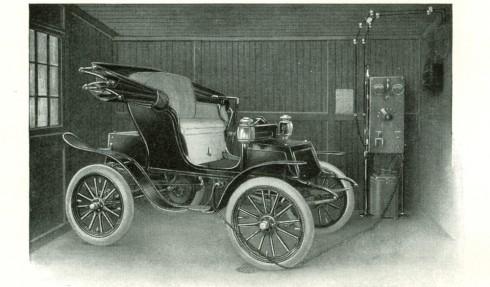The battle between gas and electric cars isn’t new
A Studebaker charging up.
In the late 1800s, the Studebaker company was the world's largest manufacturer of wagons and buggies. When the company began making automobiles, they chose to power their engines with electricity, not gasoline.
But eventually, the gasoline-powered engine became the preferred technology. Now, more than 100 years later, automakers face many of the same dilemmas and decisions as their predecessors did.
In some ways, the Studebakers have been proven right — even prophetic. “John M. Studebaker did not like gasoline-powered cars,” says Andy Beckman, the archivist at the Studebaker National Museum in South Bend, Indiana. “He said, ‘Gasoline-powered cars are clumsy, dangerous, noisy brutes that stink to high heaven and break down at the worst possible moment.’”
And really, who could argue with him, Beckman asks. When the gasoline-powered car was in its infancy, they were difficult to operate and they really did smell bad. Without emissions equipment, gasoline engines give off rather noxious fumes. Even starting the gasoline-powered car could be fatal: people were occasionally killed trying to crank start a car.
Nowadays, people rarely get killed starting their cars, although with all the auto recalls lately, drivers might be forgiven for feeling a bit unnerved. But the Studebakers were on the money about the smell and the emissions. The modern trend toward electric-powered cars is largely driven by fears of climate change, due in no small part to the CO2 released by millions of gasoline-powered cars.
Studebaker was also right about the ease of electric technology. With the early electric cars, you could hop in, flip a switch, pick your speed and drive off. The electric motor had already been developed and tested — you could order one from Westinghouse. The batteries were broadly available from a number of suppliers. “[Studebaker] was already building the coachwork for their horse-drawn vehicles, so it was just a matter of adapting a chassis to an electric vehicle, and there you go,” Beckman says.
Modern-day auto collectors still enjoy the durability of electric cars, Beckman says. Even after many years, you can throw in a battery, pump up the tires and you're probably good to go. Gasoline cars don't age as gracefully because of the fuel and other fluids.
From 1902 to 1911, Studebaker produced around 1800 electric vehicles of all kinds. Even Thomas Edison owned one. His son told the Studebaker company that Edison “drove the wheels off of it” until the early 1920s, Beckman says.
The company also made electric trucks, but those were not as succesful as the automobiles. Even so, Beckman says, compared to what they were using, which was the horse drawn vehicle, they must have been great. “The Gimbels company out of New York ordered a whole fleet of Studebaker electrics,” Beckman notes. “You didn’t need to feed the electric when it wasn’t working and you didn’t have the ‘horse exhaust’ to contend with.”
But like today, the big technological hurdle was keeping an electric car charged. Back then, a Studebaker could go 40 miles at about 20 mph before losing power. Then you would have to plug it in and recharge it, and the electrical structure of US was not set up to handle this.
“Interestingly, with the purchase of every automobile, Studebaker included a 15-foot cord to charge it with,” Beckman says. “Now, what that cord was supposed to attach to was another thing.” You could buy a device called a rectifier for your house, Beckman says, and some power plants would apparently let people drive up and plug into it if you knew what to ask for. “[Studebaker] gave instructions about what to do, because the plants were generating alternating current and the electric cars were running off of direct current, and that’s not going work too well.”
Ultimately, however, gasoline-powered cars prevailed. The gas engine was developing by leaps and bounds and gasoline was becoming more widely available. But mainly, it was development of the self-starter that drove a stake into the heart of the electric car, Beckman says. Now drivers could start a gas-powered car as easily as an electric.
And the cost of making and buying gas-powered cars kept going down. When Studebaker introduced their first gasoline-powered cars, they cost twice as much as their electric cars. Toward the end of their production run, it was the other way around — gas-powered cars cost half as much as electrics. “So, it was clear, at least to the Studebaker Corporation, that the gasoline-powered car was the way to go,” Beckman says.
After Henry Ford sold over 300,000 Model Ts in 1913, electric cars began to disappear from the automobile landscape — although they did keep popping up every now and again. A company called Detroit Electric, one of the first major manufacturers of electric cars, kept making them until the 1930s. In the late 1960s, American Motors began experimenting with several electric commuter cars, like the Amitron and the Electron — and in the 1990s GM produced the ill-fated EV1.
Now the electric car may finally be here to stay. Almost every major company has embraced at least a hybrid gas-electric technology; Tesla keeps pressing on, despite the efforts of mainstream car dealerships and politicians. And now “it looks like the Big Three US automakers have really embraced electricity as a viable alternative,” Beckman says.
So, maybe the history of the electric car really will be different this time around.
This story is based on an interview that aired on PRI's Science Friday with Ira Flatow
